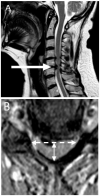Vertigo in Patients with Degenerative Cervical Myelopathy
- PMID: 34200086
- PMCID: PMC8201049
- DOI: 10.3390/jcm10112496
Vertigo in Patients with Degenerative Cervical Myelopathy
Abstract
(1) Background: Cervical vertigo (CV) represents a controversial entity, with a prevalence ranging from reported high frequency to negation of CV existence. (2) Objectives: To assess the prevalence and cause of vertigo in patients with a manifest form of severe cervical spondylosis-degenerative cervical myelopathy (DCM) with special focus on CV. (3) Methods: The study included 38 DCM patients. The presence and character of vertigo were explored with a dedicated questionnaire. The cervical torsion test was used to verify the role of neck proprioceptors, and ultrasound examinations of vertebral arteries to assess the role of arteriosclerotic stenotic changes as hypothetical mechanisms of CV. All patients with vertigo underwent a detailed diagnostic work-up to investigate the cause of vertigo. (4) Results: Symptoms of vertigo were described by 18 patients (47%). Causes of vertigo included: orthostatic dizziness in eight (22%), hypertension in five (14%), benign paroxysmal positional vertigo in four (11%) and psychogenic dizziness in one patient (3%). No patient responded positively to the cervical torsion test or showed significant stenosis of vertebral arteries. (5) Conclusions: Despite the high prevalence of vertigo in patients with DCM, the aetiology in all cases could be attributed to causes outside cervical spine and related nerve structures, thus confirming the assumption that CV is over-diagnosed.
Keywords: cervical dizziness; cervical torsion test; cervical vertigo; degenerative cervical myelopathy; degenerative cervical spinal cord compression.
Conflict of interest statement
The authors declare that they have no conflict of interest.
Figures


Similar articles
-
Relationship Between Atypical Symptoms of Degenerative Cervical Myelopathy and Segments of Spinal Cord Compression: Retrospective Observational Study.World Neurosurg. 2022 May;161:e154-e161. doi: 10.1016/j.wneu.2022.01.075. Epub 2022 Jan 29. World Neurosurg. 2022. PMID: 35092814
-
Vertigo is associated with advanced degenerative changes in patients with cervical spondylosis.Clin Rheumatol. 2011 Dec;30(12):1527-34. doi: 10.1007/s10067-011-1770-x. Epub 2011 May 20. Clin Rheumatol. 2011. PMID: 21597927
-
Benign paroxysmal positional vertigo in Parkinson's disease.Parkinsonism Relat Disord. 2013 Dec;19(12):1110-2. doi: 10.1016/j.parkreldis.2013.07.024. Epub 2013 Aug 13. Parkinsonism Relat Disord. 2013. PMID: 23948517
-
Degenerative Cervical Myelopathy: Epidemiology, Genetics, and Pathogenesis.Spine (Phila Pa 1976). 2015 Jun 15;40(12):E675-93. doi: 10.1097/BRS.0000000000000913. Spine (Phila Pa 1976). 2015. PMID: 25839387 Review.
-
Cervicogenic causes of vertigo.Curr Opin Neurol. 2015 Feb;28(1):69-73. doi: 10.1097/WCO.0000000000000161. Curr Opin Neurol. 2015. PMID: 25502050 Review.
Cited by
-
Risk factors for benign paroxysmal positional vertigo and construction of a nomogram predictive model.Am J Transl Res. 2024 Jun 15;16(6):2435-2444. doi: 10.62347/DHAJ4799. eCollection 2024. Am J Transl Res. 2024. PMID: 39006265 Free PMC article.
-
Cervicogenic Dizziness in an 11-Year-Old Girl: A Case Report.Adolesc Health Med Ther. 2021 Nov 26;12:111-116. doi: 10.2147/AHMT.S341069. eCollection 2021. Adolesc Health Med Ther. 2021. PMID: 34866956 Free PMC article.
-
Degenerative Cervical Myelopathy and Spinal Cord Injury: Introduction to the Special Issue.J Clin Med. 2022 Jul 22;11(15):4253. doi: 10.3390/jcm11154253. J Clin Med. 2022. PMID: 35893344 Free PMC article.
-
Proprioceptive Cervicogenic Dizziness Care Trajectories in Patient Subpopulations: A Scoping Review.J Clin Med. 2023 Feb 27;12(5):1884. doi: 10.3390/jcm12051884. J Clin Med. 2023. PMID: 36902670 Free PMC article.
-
Chiropractic Management of Neck Pain Complicated by Symptomatic Vertebral Artery Stenosis and Dizziness.Am J Case Rep. 2022 Oct 19;23:e937991. doi: 10.12659/AJCR.937991. Am J Case Rep. 2022. PMID: 36258651 Free PMC article.
References
Grants and funding
LinkOut - more resources
Full Text Sources

